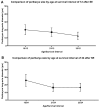Dorsal Striatum Is Compromised by Status Epilepticus Induced in Immature Developing Animal Experimental Model of Mesial Temporal Lobe Epilepsy
- PMID: 40244181
- PMCID: PMC11989456
- DOI: 10.3390/ijms26073349
Dorsal Striatum Is Compromised by Status Epilepticus Induced in Immature Developing Animal Experimental Model of Mesial Temporal Lobe Epilepsy
Abstract
This study investigated the striatopallidal complex's involvement in status epilepticus (SE) caused by morphological neurodegenerative changes in a post-natal immature developing brain in a lithium-pilocarpine male Wistar albino rat model of mesial temporal lobe epilepsy. One hundred experimental pups were grouped by age as follows: 12, 15, 18, 21, and 25 days. SE was induced by lithium-pilocarpine. Brain sections were microscopically examined by Fluoro-Jade B fluorescence stain at intervals of 4, 12, 24, and 48 h and 1 week after SE. Each interval was composed of four induced SE pups and a control. Fluoro-Jade B positive neurons in the dorsal striatum (DS) were screened and plotted on stereotaxic rat brain maps. The DS showed consistent neuronal damage in pups aged 18, 21, and 25 days. The peak of the detected damage was observed in pups aged 18 days, and the start of the morphological sequela was observed 12 h post SE. The neuronal damage in the DS was distributed around its periphery, extending medially. The damaged neurons showed intense Fluoro-Jade B staining at the intervals of 12 and 24 h post SE. SE neuronal damage was evidenced in the post-natal developing brain selectively in the DS and was age-dependent with differing morphological sequela.
Keywords: basal ganglia; degenerative neuronal changes; dorsal striatum; epilepsy; rat brain; seizure; status epilepticus.
Conflict of interest statement
The authors declare that they have no conflicts of interest.
Figures







Similar articles
-
Compartmental neuronal degeneration in the ventral striatum induced by status epilepticus in young rats' brain in comparison with adults.Int J Dev Neurosci. 2024 Jun;84(4):328-341. doi: 10.1002/jdn.10331. Epub 2024 Apr 17. Int J Dev Neurosci. 2024. PMID: 38631684
-
Neuronal degeneration is observed in multiple regions outside the hippocampus after lithium pilocarpine-induced status epilepticus in the immature rat.Neuroscience. 2013 Nov 12;252:45-59. doi: 10.1016/j.neuroscience.2013.07.045. Epub 2013 Jul 27. Neuroscience. 2013. PMID: 23896573 Free PMC article.
-
Lithium pilocarpine-induced status epilepticus in postnatal day 20 rats results in greater neuronal injury in ventral versus dorsal hippocampus.Neuroscience. 2011 Sep 29;192:699-707. doi: 10.1016/j.neuroscience.2011.05.022. Epub 2011 Jun 7. Neuroscience. 2011. PMID: 21669257 Free PMC article.
-
MicroRNA expression profile of the hippocampus in a rat model of temporal lobe epilepsy and miR-34a-targeted neuroprotection against hippocampal neurone cell apoptosis post-status epilepticus.BMC Neurosci. 2012 Sep 22;13:115. doi: 10.1186/1471-2202-13-115. BMC Neurosci. 2012. Retraction in: BMC Neurosci. 2024 Oct 17;25(1):53. doi: 10.1186/s12868-024-00908-6. PMID: 22998082 Free PMC article. Retracted.
-
The pilocarpine model of mesial temporal lobe epilepsy: Over one decade later, with more rodent species and new investigative approaches.Neurosci Biobehav Rev. 2021 Nov;130:274-291. doi: 10.1016/j.neubiorev.2021.08.020. Epub 2021 Aug 23. Neurosci Biobehav Rev. 2021. PMID: 34437936 Review.
References
MeSH terms
Substances
Grants and funding
LinkOut - more resources
Full Text Sources

